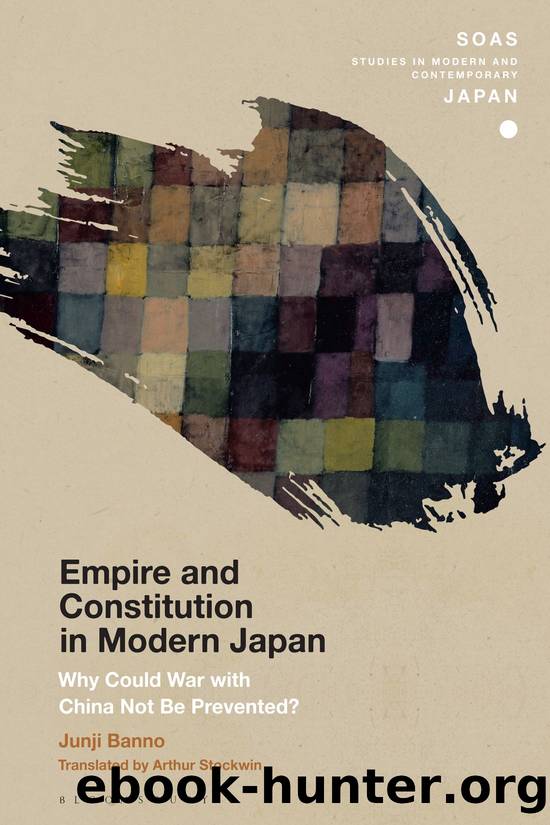Empire and Constitution in Modern Japan by Junji Banno;

Author:Junji Banno;
Language: eng
Format: epub
ISBN: 9781350136236
Publisher: Bloomsbury UK
8
The twenty-one demands to China
âConstitutionâ domestically, âEmpireâ externally
The rise of Yoshino SakuzÅ
The point of reference throughout this book is the idea that when âConstitutionâ was strong, âEmpireâ was restrained, and when âEmpireâ was strong, âConstitutionâ ran out of breath. The idea of âConstitution domestically, Empire externallyâ, meaning that both of them coexisted simultaneously, is however mistaken as a way of understanding Japanese modern history. But during the second cabinet of Åkuma Shigenobu (April 1914âOctober 1916), which came to office following the ending of the TaishÅ Political Crisis, the contrast between the domestic and the external situation did fit this model exceptionally.
This cabinet, which absorbed the results of the TaishÅ Political Crisis, institutionalized âConstitutionâ. In so far as the controlling regime after the Russo-Japanese War was a cooperative enterprise between the military clique, the bureaucratic clique and the SeiyÅ«kai as the eternal ruling party, the Siemens Affair, in which the masses targeted the SeiyÅ«kai, may be regarded as the culmination of the TaishÅ Political Crisis.
The second Åkuma Cabinet was a kind of ânon-SeiyÅ«kaiâ Cabinet consisting of what may be called a âgovernment partyâ, or a âquasi-government partyâ, including the Rikken DÅshikai of KatÅ Takaaki, the Rikken KokumintÅ of Inukai Tsuyoshi, and the ChÅ«seikai of Ozaki Yukio. The SeiyÅ«kai, for the first time since its foundation, was forced into the position of a party in the political wilderness. Ever since the Imperial Edict establishing a Constitutional Regime, issued in 1875, which had meant combining confrontation with cooperation between the domain-clique and the parties, what seems now to have arrived was a system of two major parties competing for power between them.
In the election law at the time, however, a large majority of the 1,500,000 electors were rural landlords, and since the âthree anti-SeiyÅ«kai factionsâ forming the government party behind the Åkuma Cabinet engaged in continual combat with the SeiyÅ«kai, there was no alternative but to expand the electoral roll and pick up votes from the city commercial and industrial classes, as well as the votes of ordinary people. The man who presented this idea most clearly was Professor Yoshino SakuzÅ of Tokyo Imperial University, who had recently returned from Europe and America. Just after the formation of the second Åkuma Cabinet, the journal TaiyÅ (Sun) published an article by Yoshino, titled âThe collapse of the Yamamoto Cabinet and the establishment of the Åkuma Cabinetâ. This was a rare example of an analysis of the unfolding drama of a change of government from the viewpoint of a political scientist with a long-term perspective.
Yoshino presented the differences between the party politics he himself had witnessed in Western Europe between 1910 and 1913, and party politics in Japan.
For a long time Japanese political parties have only been able to expand their party base once they have obtained power, but this is just the opposite of parties in the advanced countries of Western Europe. In their case, they can only come to power once they have developed their party strength among the people. . . .
Download
This site does not store any files on its server. We only index and link to content provided by other sites. Please contact the content providers to delete copyright contents if any and email us, we'll remove relevant links or contents immediately.
| Africa | Americas |
| Arctic & Antarctica | Asia |
| Australia & Oceania | Europe |
| Middle East | Russia |
| United States | World |
| Ancient Civilizations | Military |
| Historical Study & Educational Resources |
Never by Ken Follett(2873)
The Man Who Died Twice by Richard Osman(2291)
Machine Learning at Scale with H2O by Gregory Keys | David Whiting(2269)
Fairy Tale by Stephen King(2059)
Will by Will Smith(2033)
Rationality by Steven Pinker(1761)
The Dawn of Everything: A New History of Humanity by David Graeber & David Wengrow(1565)
The Dark Hours by Michael Connelly(1563)
Principles for Dealing With the Changing World Order: Why Nations Succeed and Fail by Ray Dalio(1368)
Friends, Lovers, and the Big Terrible Thing by Matthew Perry(1324)
A Short History of War by Jeremy Black(1295)
HBR's 10 Must Reads 2022 by Harvard Business Review(1251)
Go Tell the Bees That I Am Gone by Diana Gabaldon(1231)
Can't Hurt Me: Master Your Mind and Defy the Odds - Clean Edition by David Goggins(1223)
515945210 by Unknown(1205)
Fear No Evil by James Patterson(1106)
443319537 by Unknown(1069)
Works by Richard Wright(1017)
Going There by Katie Couric(989)
